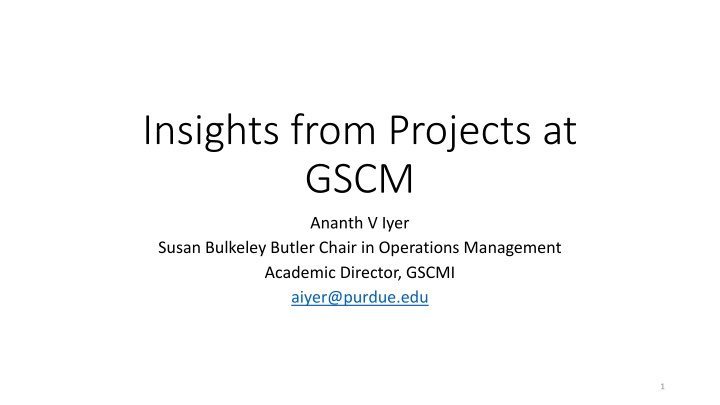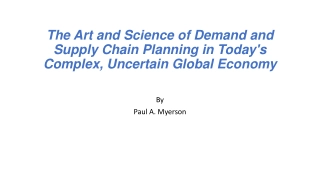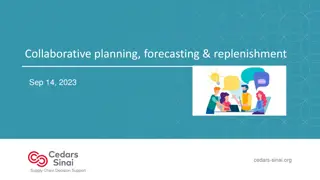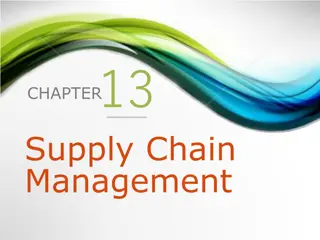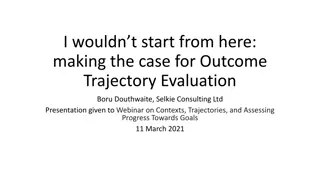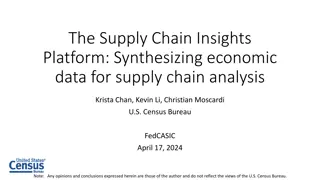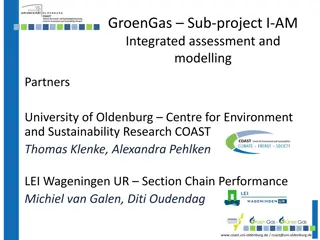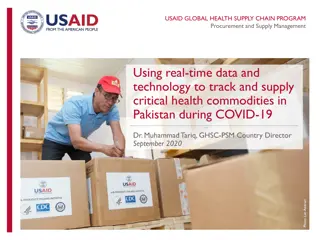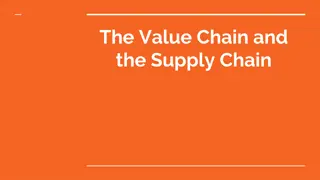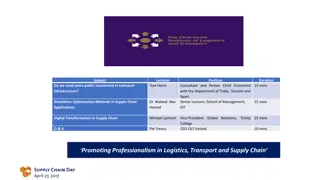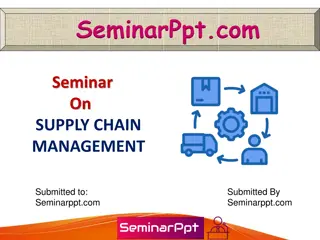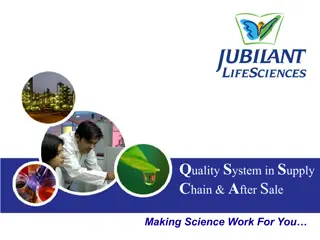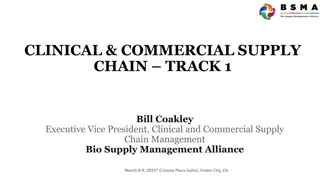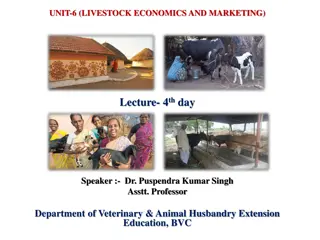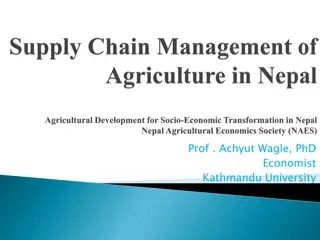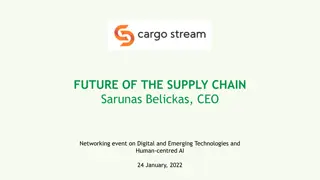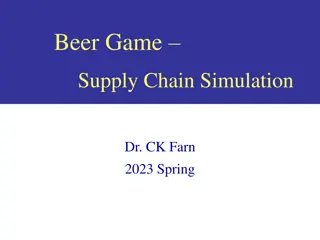Insights from Projects at GSCM: Future Trajectories for Growth and Supply Chain Impacts
Agenda includes future growth trajectories, impacts on EV demand and critical materials, scenarios for sustainability-focused growth, and analysis of supply chain constraints. SSP data shows significant impact on global GDP by 2050. Projects focus on understanding EV volumes, demand for batteries and magnets, and fixing supply-demand mismatches. EV demand forecasts span different scenarios including SSP5 with RCP. Department of Energy project aims to analyze supply chain constraints, EV volumes, battery and magnet demand, material level demand, and opportunities to address gaps.
Download Presentation

Please find below an Image/Link to download the presentation.
The content on the website is provided AS IS for your information and personal use only. It may not be sold, licensed, or shared on other websites without obtaining consent from the author.If you encounter any issues during the download, it is possible that the publisher has removed the file from their server.
You are allowed to download the files provided on this website for personal or commercial use, subject to the condition that they are used lawfully. All files are the property of their respective owners.
The content on the website is provided AS IS for your information and personal use only. It may not be sold, licensed, or shared on other websites without obtaining consent from the author.
E N D
Presentation Transcript
Insights from Projects at GSCM Ananth V Iyer Susan Bulkeley Butler Chair in Operations Management Academic Director, GSCMI aiyer@purdue.edu 1
Agenda Future: The future trajectories for growth (now to 2050) and global supply chain impacts DOE Projects: The impact on Electric Vehicle demand, thus batteries and magnets, thus critical materials. Supply/ Demand forecasted issues INDOT Projects: Impact at the county level in Indiana and projects to enable growth Summary 2
Scenarios Thinking about the future SSP Shared Socio-Economic Pathways SSP 1: predicts a world of sustainability-focused growth SSP 2 is the middle of the road, follows historical events (RCP 6.7) SSP 3 represents a fragmented world/ Regional rivalry SSP 4 is a world of ever-increasing inequality SSP 5 is a world unconstrained growth Fossil-fueled Development (RCP 8.5) RCP Representative Concentration Pathways - levels of greenhouse gases and regulatory constraints on the emission RCP2.6 is a stringent regulation allowing ~450 ppm CO2 emission. (Paris Agreement) RCP4.5 allows ~660ppm CO2 emission so less stringent mitigation efforts, etc. Why does the SSP-RCP regime matter ? (RCP 5.5) (RCP 7.2) (RCP 5.8) 3
All SSP data available at https://tntcat.iiasa.ac.at/SspDb/dsd?Action=htmlpage&page=20 Scenario Region In US $2005 billions/year 2050 SSP1 World 284564.683 SSP2 World 229718.399 SSP3 World 177283.735 SSP4 World 219216.134 SSP5 World 360926.061 SSP impacts world GDP significantly 4
Department of Energy Project Analyze the impact of supply chain constraints for Critical Materials Understand Electric Vehicle (EV) volumes Project demand for batteries and magnets Understand the associated demand at the materials level Project supply demand mismatches Explore opportunities to fix those gaps 5
Note that SSP5 with RCP spans most of the EV forecasts by consultants 7 SSP5-ECP 2.6 AEO 6 BNEF 5 BCG EV demand (millions) Energy Innovation 4 Wood Mackenzie EEI/IEI 3 SSP5 Baseline 8.5 2 SSP5 SSP5, RCP2.6 Mckinsey baseline 1 Mckinsey aggressive 0 2018 2019 2020 2021 2022 2023 2024 2025 2026 2027 2028 2029 2030 6
Battery Scenarios in the Future kWh Manganese (kg) Lithium (kg) Nickel (kg) Cobalt (kg) 64 NMC111 NMC532 NMC622 NMC811 NCA NMC9.5.5 LMO 2.5 LFP 19.2 7.68 19.2 19.2 14.4 9.6 24 9.6 10.88 35.84 0 60.8 6.4 0 8 8 4.8 8 4.48 32.64 10.88 35.84 48.81066667 4.48 45 2.5 0 0 0 0 9.152 Year NMC111 NMC532 NMC622 NMC811 NCA NMC9.5.5 LMO LFP 2020 2025 2020 2025 2030 2030 2020 2025 2030 2030 45% 38.5% 23% 34% 40% 38% 23% 40% 13% 14% 8% 42% 2% 10% 8% 26% 24% 14% 10% 41% 36% 34% 17% 5% 2% 2% 1% 1% 15% 10% CRU 7.5% 32% 35% 25% 50% 8% 46% 58% 25% Mckinsey 2% 37% IEA 5% 33% 4% BNEF EST 16% 0.0085 Battery Technologies are evolving and use different mix of materials To find the content for each element till 2050, we use a regression based estimate. 8
Cobalt 9
Cobalt Baseline Without Recycling Without Recycling (ktonnes) Co for EV US Demand SSP2 Baseline SSP5 Baseline SSP 2 Baseline Supply SSP 5 Baseline Supply 2020 2025 2030 2035 2040 2045 2050 10.40238733 16.83485 23.87966 31.25307 38.73754 46.03995 8.167894228 12.24662 17.2476 23.10346 29.55921 36.51266 43.76176 6.327884408 9.13689 12.96966 14.39952 6.773511011 10.44084 15.38665 17.58294 19.96722 22.85395 26.13604 52.7937 15.8122 17.23409 18.6458 SSP baseline demands are not met by the respective supplies SSP2 baseline demand for 2050 is 52 k-tonnes and the supply is 18 k-tonnes. SSP5 baseline demand in 2050 is 43 k-tonnes and supply is 26 k-tonnes Baseline Without Recycling 60 50 40 30 26.13603528 20 18.64580369 10 0 2020 2025 2030 2035 2040 2045 2050 SSP 2 Baseline SSP 5 Baseline SSP 2-Baseline Supply SSP 5-Baseline Supply 10
Cobalt - Baseline with Recycling Baseline With Recycling (CR 1) Baseline With Recycling (CR 0.6) 70 60 57.38334494 60 50 43.87155959 55.69524247 50 40 40 30 30 20 20 10 10 0 0 2020 2025 2030 2035 2040 2045 2050 2020 2025 2030 2035 2040 2045 2050 SSP 2 Baseline SSP 5 Baseline SSP 2 Baseline SSP 5 Baseline SSP 2-Baseline Supply SSP 5-Baseline Supply SSP 2-Baseline Supply SSP 5-Baseline Supply SSP 2 Baseline supply without rec. SSP 5 baseline supply without rec. SSP 2 Baseline supply without rec. SSP 5 baseline supply without rec. Baseline supply including recycling fulfills demand at collection rate of 100% SSP2 baseline/CR 1, the total 2050 supply is 57.38 k-tonnes and the demand is 52.7 k-tonnes. With Recycling Co for EV US Demand SSP2 Baseline SSP5 Baseline SSP 2 Baseline Supply SSP 5 Baseline Supply 2020 2025 2030 2035 2040 2045 2050 10.40238733 16.83485 23.87966 31.25307 38.73754 46.03995 8.167894228 12.24662 17.2476 23.10346 29.55921 36.51266 43.76176 6.327884408 9.13689 23.37205 31.23437 39.69186 48.48716 57.38334 6.773511011 10.44084 23.55454 29.82956 37.21481 52.7937 Collection rate 60%, then in 2050 there is a shortage for SSP2, and just enough supply for SSP 5 45.9574 55.69524 11
Cobalt RCP 2.6 with Recycling RCP 2.6 With Recycling (CR 0.6) RCP 2.6 With Recycling (CR 1) 160 160 140 140 120 120 104.4759813 100 100 67.26450229 80 80 60 80.28142345 60 51.76767981 40 40 20 20 0 0 2020 2025 2030 2035 2040 2045 2050 2020 2025 2030 2035 2040 2045 2050 SSP2-2.6 SSP 5-2.6 SSP 2-2.6 Supply SSP2-2.6 SSP 5-2.6 SSP 2-2.6 Supply SSP 5-2.6 Supply SSP2-2.6 without rec. SSP 5-2.6 without rec. SSP 5-2.6 Supply SSP2-2.6 without rec. SSP 5-2.6 without rec. For RCP scenarios, collection rate of 100%, there is a shortage for SSP2 and SSP 5. In 2050, for SSP2 and SSP5 the supply is 80kt and 104kt whereas the demand is 99kt and 147kt respectively. If the collection rate is 60%, then the gap increases further. With Recycling Co for EV US Demand SSP2-2.6 SSP 5-2.6 SSP2-2.6 Supply SSP 5-2.6 Supply 2020 2025 2030 2035 2040 2045 2050 15.133908 27.65038 41.55061 56.24896 71.28436 86.06304 99.84895 15.56184099 29.73274 47.54418 68.9047 6.089813891 7.840333 25.04018 37.39737 51.00925 65.51504 80.28142 6.005394984 8.559722 27.3686 41.616 59.55578 80.60731 93.0287 119.4946 147.5408 104.476 12
What have we learned The global political relationships matter for world GDP The RCP (emissions control) matters it does not impact GDP much, but it does impact use of EVs (and Wind Turbines) In the absence of recycling, material shortages and thus difficulty attaining target emissions reductions With recycling, most of the supply gap is decreased Thus, a robust recycling system, combined with technology improvement can enable a stable supply chain 13
INDOT Project How will Indiana and its counties grow in the future ? What road capacity increases will be needed to support economic growth ? Use the same SSP-RCP scenario approach to project county GDP growth Capture county level industries, truck volume intensity Identify congestion in roads Project a priority for new projects 14
INDOT PROJECT OVERVIEW Ramp infrastructure planning tool for INDOT Anticipating future traffic increase due to industry growth Comparing current level of service Facilitating congestion free expansion of industries in Indiana 15
DVMT Daily Vehicle Miles Travelled CLUSTERING USING TOTAL GDP Clustering was conducted using Total GDP* (Aggregate of Manufacturing, Wholesale, Retail, Transportation, Construction) Conducted stepwise regression independently for each cluster As in the previous model each cluster had a moderately good linear fit with an exception of Dubois, Monroe and Kosciusko A separate cluster was created for said counties Cluster 1 Bartholomew Elkhart Howard Tippecanoe Cluster 2 Allen Clark Hamilton Hendricks Porter St. Joseph Cluster 3 Delaware Floyd Gibson Johnson Vigo Wayne Cluster 4 Dubois Kosciusko Monroe High growth in DVMT with increase in Mfg. GDP Moderate growth in DVMT with increase in Mfg. GDP Very low GDP resulting in minimal increase in DVMT No apparent trend 16
Tippecanoe county GDP forecasts Scenario Region 2020 2025 2030 2035 2040 2045 2050 SSP1 Tippecanoe 7.787 8.634 9.505 10.377 11.214 12.002 12.720 SSP1-26 Tippecanoe 7.787 8.634 9.505 10.377 11.214 12.002 12.720 SSP2 Tippecanoe 7.743 8.474 9.144 9.757 10.339 10.887 11.393 SSP2-26 Tippecanoe 7.733 8.453 9.112 9.706 10.269 10.793 11.276 SSP3 Tippecanoe 7.604 8.167 8.613 8.972 9.272 9.515 9.680 SSP3-34 Tippecanoe 7.601 8.156 8.595 8.855 9.064 9.243 9.349 SSP4 Tippecanoe 7.721 8.532 9.355 10.161 10.901 11.571 12.164 SSP4-26 Tippecanoe 7.722 8.540 9.369 10.167 10.900 11.568 12.160 SSP5 Tippecanoe 7.914 8.986 10.221 11.576 12.981 14.466 16.035 SSP5-26 Tippecanoe 7.914 8.956 10.164 11.418 12.733 14.081 15.519 17
Tippecanoe county forecasted ramp congestion Tippecanoe county congestion grows from 1 ramp to 8 ramps in 2050 under SSP5 Congested Ramps in Tippecanoe 18
Summary Future growth forecasts are impacted by geo-political outcomes Tippecanoe county s growth is impacted by these global issues Unless we plan, ramps get congested It is important for the micro level choices to be synchronized with macro level shifts Being quantitative gets us to realize the urgency and make choices 19
Thank you Ananth V Iyer aiyer@purdue.edu 20
